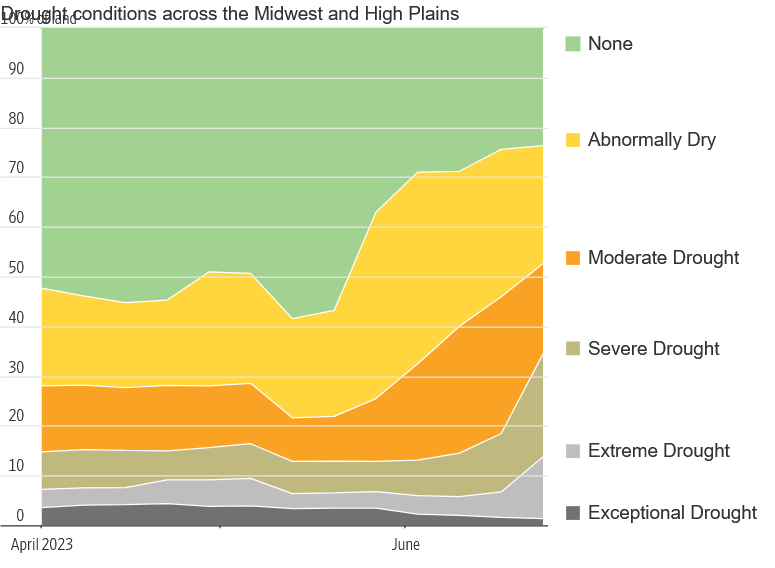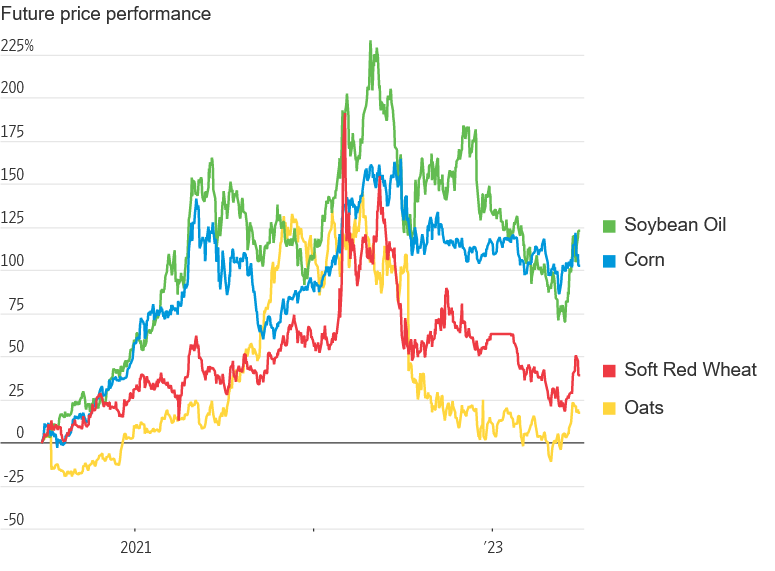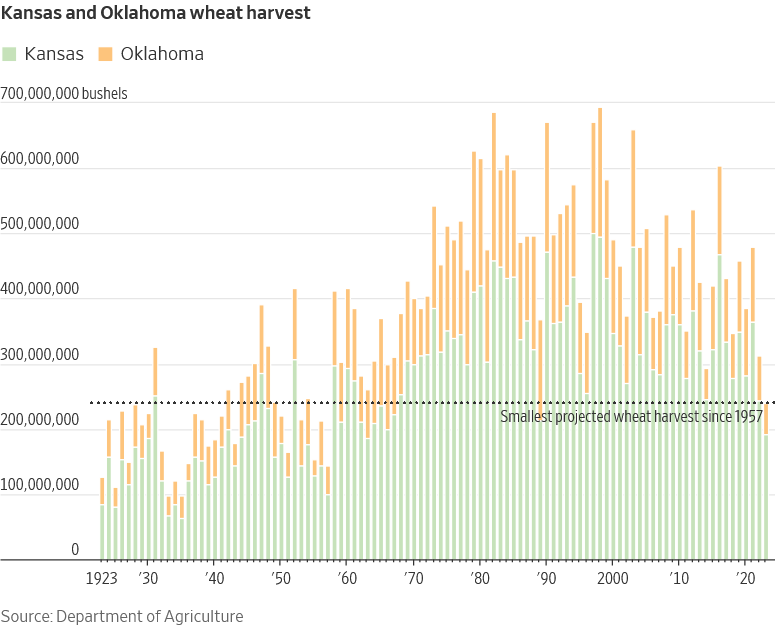As if our food system hadn't been strained enough with the COVID-19 pandemic and geopolitical tensions such as Russia's invasion of Ukraine, a new menace looms over the American economy - a severe drought is threatening the country's breadbasket. While food costs were showing signs of stability, this latest blow threatens to reignite food inflation and disrupt the efforts of farmers across the nation.
 SourceMoneyGuru-https://www.mgkx.com/4881.html
SourceMoneyGuru-https://www.mgkx.com/4881.html
The drought is stretching across the wheat fields of the Great Plains and the Corn Belt of the Upper Midwest, with some areas receiving only a fraction of their usual rainfall. The threat of reduced crop yield is ominously reminiscent of 2012's drought, which caused crop prices to surge drastically. The current conditions are crucial, as they coincide with key growing periods for corn and soybeans.SourceMoneyGuru-https://www.mgkx.com/4881.html
As Angie Setzer, co-founder of Consus, aptly puts it, "The next three to four weeks are going to be huge.” Consus, a firm that advises farmers on minimizing financial risks and effectively selling crops, is closely monitoring the situation.SourceMoneyGuru-https://www.mgkx.com/4881.html
In recent months, there has been a slight reprieve in U.S. food inflation as crop prices fell. However, early June brought with it a renewed fear of drought-stunted crops and abandoned fields, which, in turn, drove up prices for key ingredients used in foods like dinner rolls, pizza dough, and oatmeal. Despite some relief in the form of scattered rainfall, hopes for a fully salvaged harvest and moderated price increases remain uncertain.SourceMoneyGuru-https://www.mgkx.com/4881.html
The Chicago trading contracts for future deliveries of soft red wheat used widely in baked goods saw a hike of more than 11% since June. Similarly, oat prices and soybean oil, used for frying, baking and as low-carbon trucking fuel, climbed by 8.5% and surged by 32% respectively. Corn experienced a slight dip of about 4.5% following recent rains that reversed an earlier rally.SourceMoneyGuru-https://www.mgkx.com/4881.html
These conditions, monitored by federal record-keepers, have worsened to the extent that some farmers are contemplating whether it's worth the effort to harvest weak crops. The expectation is for farmers to abandon scorched winter wheat fields at the highest rate since 1917, surpassing even the abandonment rates of the 1930s Dust Bowl.SourceMoneyGuru-https://www.mgkx.com/4881.html
In Syracuse, Kan., farmer Jason Ochs anticipates harvesting only a third of the wheat sown on his family's 20,000-acre farm. For Ochs, the double whammy of drought and inflation has made this year the most challenging in his twelve-year farming career. He now pins his hopes on recent precipitation aiding the growth of dryland corn and grain sorghum in other parts of his property.SourceMoneyGuru-https://www.mgkx.com/4881.html
An array of crop prices had approached record highs in the aftermath of Russia's invasion of Ukraine, a major grain-exporting region. This sparked inflation and threatened food supplies in lower-income countries until a deal, brokered by the United Nations, allowed grain exportation through the Black Sea into the global market.SourceMoneyGuru-https://www.mgkx.com/4881.html
However, just as prices began to retreat, commodity markets are facing a new period of uncertainty with Ukraine's counteroffensive and the expiration of the Kyiv-Kremlin grain export deal. Additionally, hotter, drier weather typically hits U.S. farms in July, making the situation potentially worse.SourceMoneyGuru-https://www.mgkx.com/4881.html
Hedge funds, expecting a bumper crop to keep prices down, have been taken aback by this "double whammy." A shift has been observed among speculators, who are now placing bets to cover the risk, contributing to the recent run-up in prices.SourceMoneyGuru-https://www.mgkx.com/4881.html
According to the U.S. Drought Monitor, nearly a third of the High Plains and almost two-thirds of the Midwest are in at least moderate drought. Extreme or exceptional drought has left the soil parched across sections of Kansas, Nebraska, Oklahoma, Texas, and Missouri. While some fields in Iowa, known as the corn capital of the U.S., have survived thanks to crossbreeding that made crops more resilient, even they may require additional rainfall to endure through the summer.SourceMoneyGuru-https://www.mgkx.com/4881.html
Relief may be on the horizon for parts of the Midwest, but it brings its own challenges. The National Oceanic and Atmospheric Administration (NOAA) warns of a band of rain moving across the region, which could potentially lead to flash floods in parts of Nebraska, Iowa, and Illinois. The intensity of the precipitation increases the risk of runoff rather than the much-needed absorption into the soil.SourceMoneyGuru-https://www.mgkx.com/4881.html
Justin Glisan, the climatologist for the state of Iowa, emphasizes the need for gentle thunderstorm rainfall. The ideal scenario would involve a slow, steady rain that allows the soil to soak up the moisture effectively. However, an intense downpour may cause excessive runoff, resulting in soil erosion and nutrient loss.SourceMoneyGuru-https://www.mgkx.com/4881.html
The implications of this drought are far-reaching, with potential ramifications for food prices and the overall economy. As crop yields are expected to be reduced, the scarcity of key agricultural commodities like wheat, corn, soybeans, and oats is likely to drive up their prices. This, in turn, can have a ripple effect on other sectors of the economy, as food and feed costs increase, impacting consumers, livestock farmers, and food manufacturers alike.SourceMoneyGuru-https://www.mgkx.com/4881.html
 SourceMoneyGuru-https://www.mgkx.com/4881.html
SourceMoneyGuru-https://www.mgkx.com/4881.html
 SourceMoneyGuru-https://www.mgkx.com/4881.html
SourceMoneyGuru-https://www.mgkx.com/4881.html
 SourceMoneyGuru-https://www.mgkx.com/4881.html
SourceMoneyGuru-https://www.mgkx.com/4881.html
Furthermore, higher food prices can contribute to inflationary pressures. The recent easing of food inflation due to falling crop prices might be short-lived if the drought persists. With the ongoing supply chain disruptions and other economic challenges, the potential for sustained food inflation poses additional hardships for individuals and families already grappling with financial strain.SourceMoneyGuru-https://www.mgkx.com/4881.html
The agricultural sector is vital not only for domestic food security but also for global food supplies. The impact of the U.S. drought on crop yields and food prices can have implications beyond national borders, particularly for countries that rely on imports of agricultural commodities. Higher food prices can exacerbate food insecurity and pose significant challenges for vulnerable populations, especially in lower-income countries.SourceMoneyGuru-https://www.mgkx.com/4881.html
Addressing the challenges posed by the drought requires a multi-faceted approach. Farmers and agricultural experts are continuously exploring innovative techniques and technologies to mitigate the impact of water scarcity on crop production. This includes advancements in irrigation systems, drought-tolerant crop varieties, and precision farming practices that optimize water usage.SourceMoneyGuru-https://www.mgkx.com/4881.html
Policy interventions and support mechanisms are also crucial to assist farmers during challenging times. This includes access to affordable credit, insurance programs, and government assistance to help alleviate the financial burden and protect against potential losses. Additionally, investments in research and development can further enhance the resilience of crops and the agricultural sector as a whole.
As consumers, we can play our part by being mindful of our food choices and supporting sustainable agricultural practices. Opting for locally sourced and seasonal produce, reducing food waste, and promoting conservation efforts can contribute to a more resilient and sustainable food system.
The current drought serves as a reminder of the vulnerability of our agricultural systems to climatic fluctuations and other external factors. It underscores the importance of proactive measures, both at the individual and systemic levels, to build resilience and ensure the stability of our food supply chains.
While the situation remains uncertain, it is crucial to monitor developments closely and adapt strategies to navigate the challenges ahead. By working together, we can mitigate the impact of the drought and strive towards a more sustainable and secure food future.












